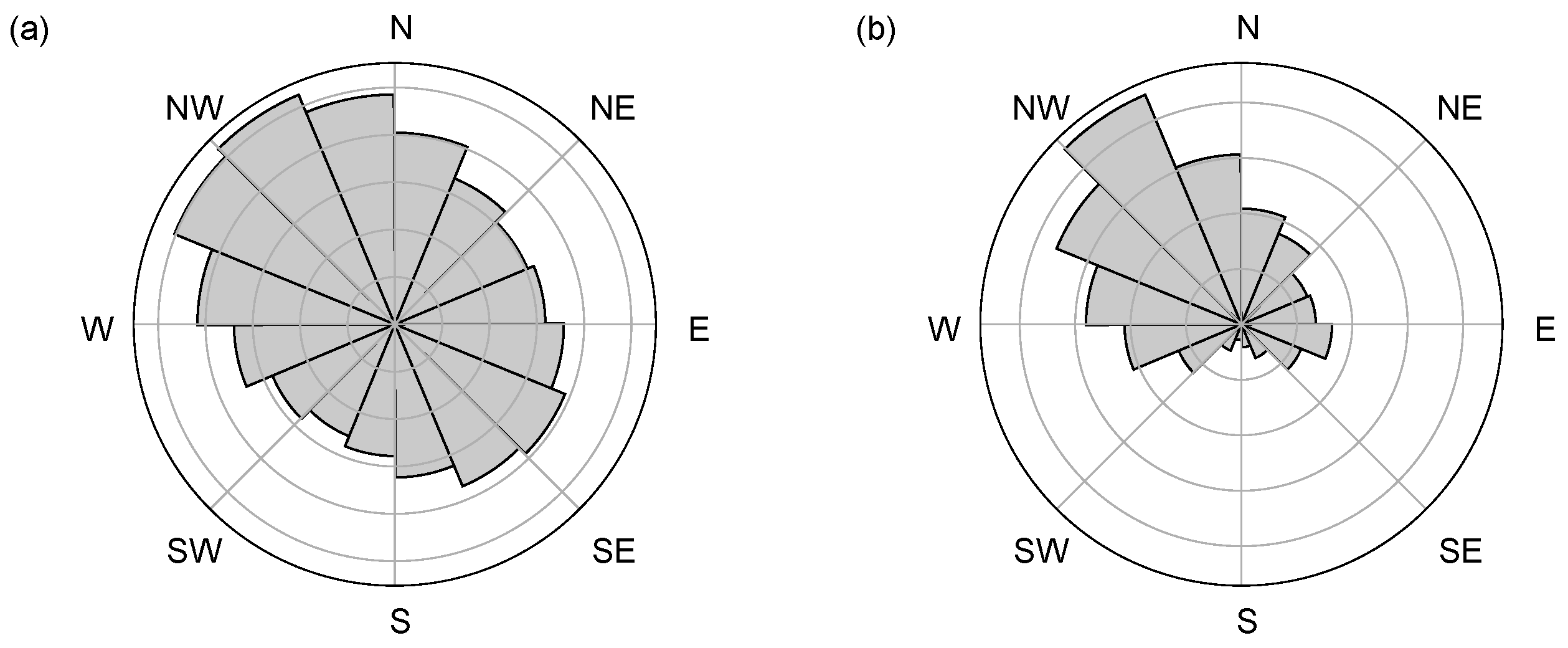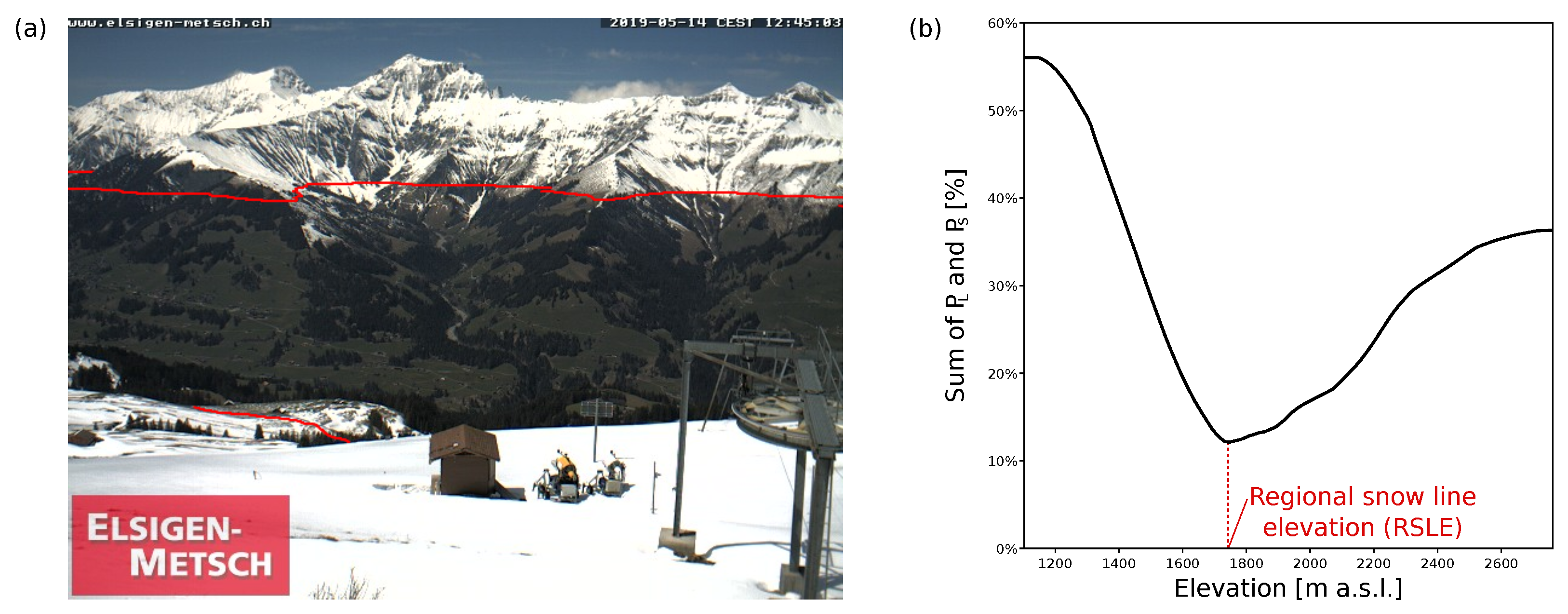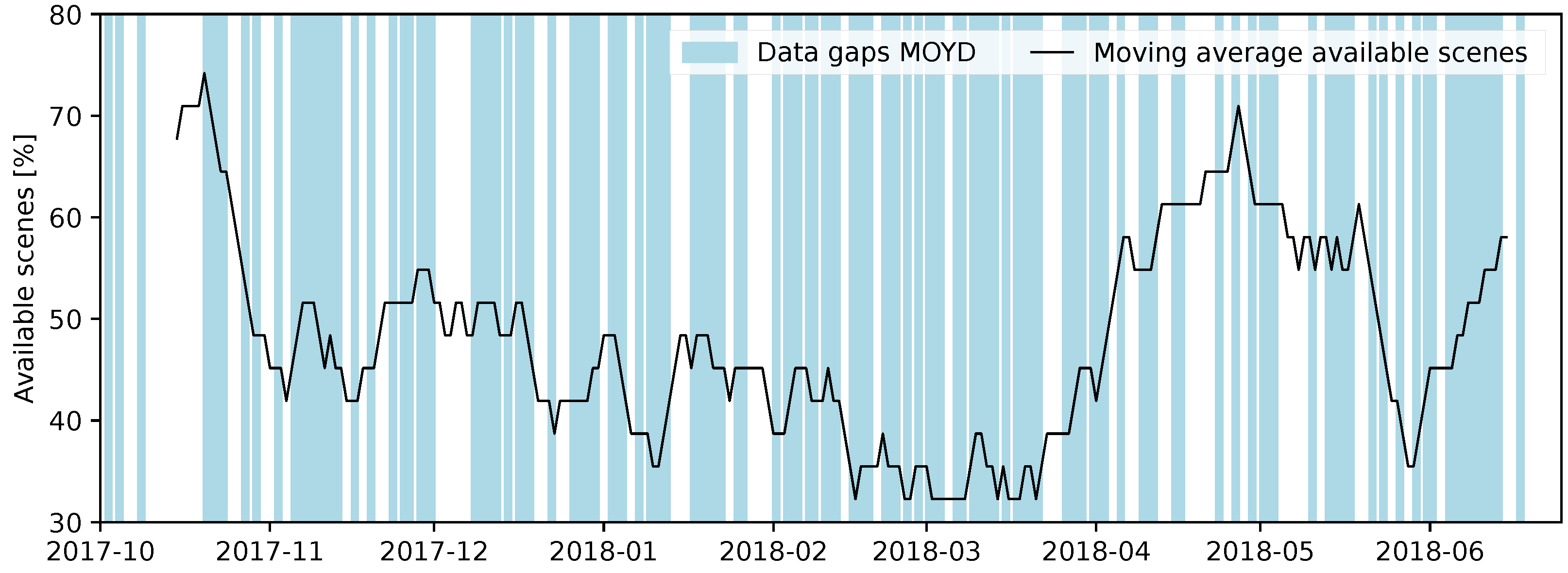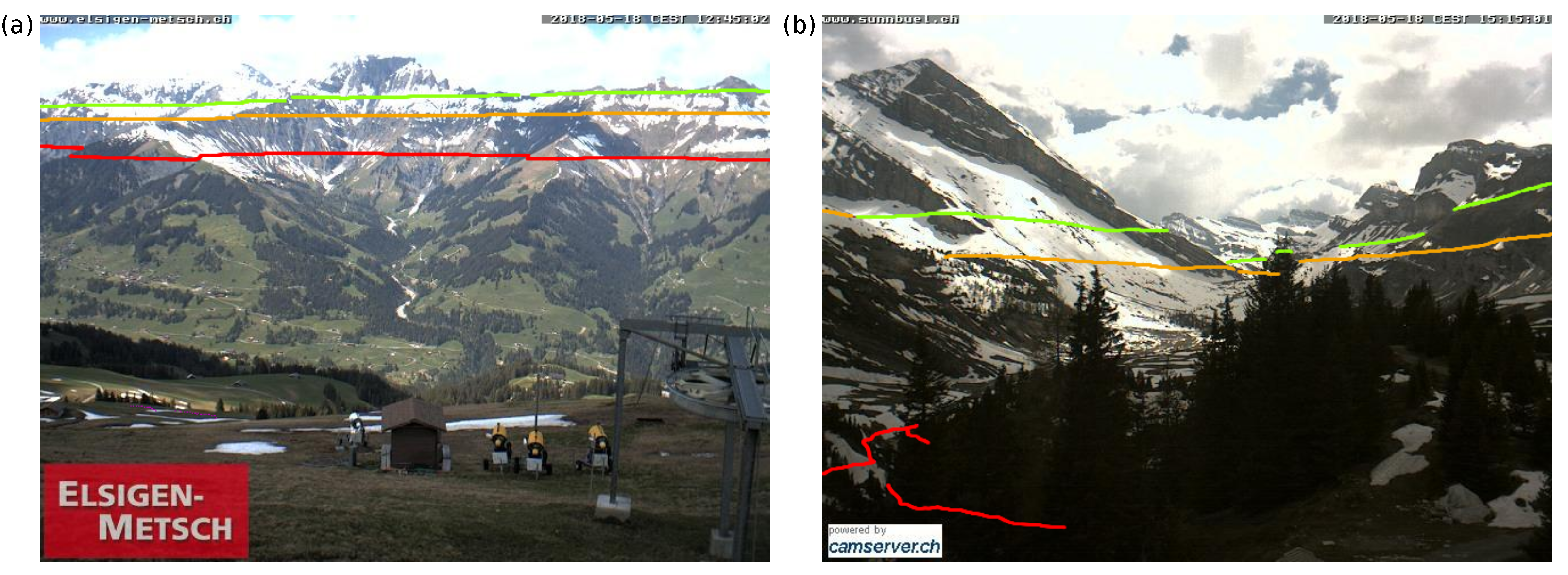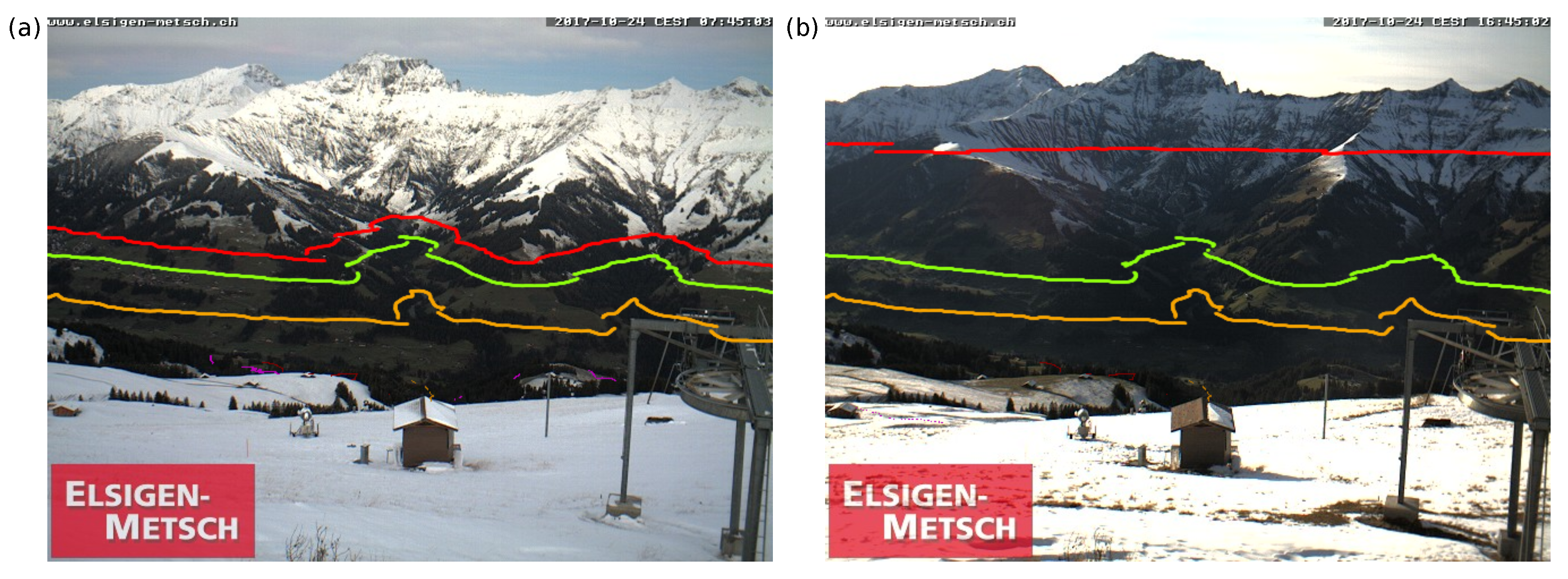1. Introduction
Snow cover is highly variable, both spatially and temporally, and it is a crucial element of the Earth’s climate system. Seasonal snow cover highly influences the radiation budget and water fluxes between the surface and the atmosphere, and it plays a significant role in the warming of the climate through snow–albedo feedback due to its high reflectance [
1]. Mountain regions are particularly sensitive to changes in the extent of snow cover. Snow melt has a high impact on the availability of water resources and accounts substantially for the annual runoff generation in alpine catchment areas [
2]. Moreover, changes in snow cover influence mountain ecology and socio-economic systems [
3,
4,
5]. It is therefore essential to observe and analyze snow cover variability at a high spatiotemporal resolution.
Optical remote sensing is a measurement technique that is widely used to analyze snow-cover dynamics over large areas; see, e.g., [
6,
7,
8,
9]. In comparison to ground-based station measurements, satellite-based data can capture the spatial distribution of the snow extent. However, limitations exist in both spatial and temporal resolutions. For example, snow cover products generated from the Moderate Resolution Imaging Spectroradiometer (MODIS) can offer a daily coverage but a relatively low spatial resolution of 500 m [
10]. On the contrary, Sentinel-2 snow cover maps provide a high spatial resolution of 20 m but only a 5-day revisit time [
11]. Moreover, cloud cover has a high impact on observing snow dynamics since it can significantly limit the number of available scenes and the ability to accurately mapping snow cover extent using optical satellite data [
12,
13]. Spatial and temporal gap-filling methods are the most widespread methods used to reduce the impact of cloud cover on data availability. However, these methods either are unable to remove all the cloud cover in large areas or introduce uncertainties that increase with the length of the data gaps [
13,
14].
Terrestrial photography is an observation method increasingly used to analyze snow cover variability at a high spatiotemporal resolution; see, e.g., [
15,
16,
17,
18,
19,
20,
21,
22,
23,
24]. Recently, ground-based cameras have been proposed to validate satellite-based snow cover information [
25,
26] and have been identified as a unique data set for precisely monitoring snow cover in mountainous regions [
21,
27,
28]. Moreover, snow cover maps based on ground-based cameras have been used to continuously calibrate threshold values based on the Normalized Difference Snow Index (NDSI) for Landsat satellite images [
29]. In contrast to satellite-based systems, ground-based cameras are typically able to monitor and detect features below cloud cover. In addition, the temporal resolution, or measurement interval, is practically unlimited. These reasons render measurements from ground-based cameras feasible for complementing satellite-based snow cover retrieval. Besides the studies presented by [
22,
28], the above mentioned studies focus on small-catchment areas, i.e., rely on a handful of cameras with only a limited areal coverage.
Public webcam images offer a significant potential to combine local-scale snow cover information at high spatio-temporal resolutions with an increased areal coverage due to their high availability. In Switzerland, for instance, several thousands of public webcams are freely accessible. Public webcams are less affected by cloud cover in comparison to camera networks covering small catchment areas, since the distribution of public webcams over larger areas enables a compensation of data gaps thanks to the spatial variability in cloud cover. Recently, the feasibility of using these webcams to retrieve snow cover information has been demonstrated [
28].
This study builds on the work presented by Portenier et al. [
28] with the purpose of highlighting the ability of public webcams to improve and complement satellite-based snow cover retrieval by contributing additional snow cover information. Between October 2017 and the end of June 2018, we studied the regional snow line elevation in an alpine catchment area using public webcams. The snow line, i.e., the transition between snow-covered and snow-free areas, is a suitable indicator to describe snow cover distribution in mountainous regions. We follow the definition and methodology proposed by Krajčí et al. [
30], which define the Regional Snowline Elevation (RSLE) as the elevation for which the sum of snow pixels below and snow-free pixels above that elevation is minimized. Previous studies have already shown that terrestrial camera systems are an effective tool to monitor the variability in the snow line at small catchment scales [
17,
21]. We want to demonstrate that public webcams are an attractive and appropriate data source to estimate regional snow-line elevation at larger scales as well. The large number of public webcams enables us to analyze the temporal variability of the snow line over large areas. We compare snow-line elevation derived from webcams to snow-line estimates from existing MODIS and Sentinel-2 snow cover products and investigate their differences. In addition, we analyze the impact of cloud cover on data availability and demonstrate the feasibility to fill gaps in satellite-based snow cover time-series caused by cloudy conditions using webcams.
We first briefly describe the workflow to generate daily webcam-based snow cover maps (
Section 2.1). Next, we create binary snow-cover data sets generated from daily MODIS Terra and Aqua snow-cover products and Sentinel-2 fractional snow-cover (FSC) maps provided by the NASA Distributed Active Archive Center at the National Snow and Ice Data Center (NSIDC) and the Copernicus Land Monitoring service (CLMS), respectively, (
Section 2.2). In
Section 2.3, the study area is described in detail, and the fraction observed by the webcams is put into context for the entire study area. In
Section 2.4, we present the RSLE method proposed by Krajčí et al. [
30]. A detailed analysis and comparison of the RSLE estimates derived from different measurements and the impact of cloud cover on the temporal resolution of the different data sets is presented in
Section 3, followed by an in-depth discussion in
Section 4.
3. Results
3.1. Impact of Cloud Cover on Temporal Resolution
The percentage of daily webcam images covered by clouds varies across different webcams (see
Figure 6). In general, webcams observing smaller areas close to the camera are least affected by cloud coverage. If the observed area spans less than
m
(which holds for half of the selected webcams), less than
of the daily webcam images contain some cloud cover. On the other hand, the webcam Adelboden Chefihuesi, which observes an area of 2.3 km
, is affected by cloud cover in
of the daily images.
As mentioned in
Section 2.1, an average of 14.3 webcam images per day were available. On average,
images were fully cloud covered, and
images were partly cloud covered. Since we manually labeled images with partial cloud coverage, we were able to use an average of 13.9 webcam images per day to estimate the RSLE. On six days, at most 10 images were available. Whether a decreased number of webcams affects the accuracy of the RSLE estimate depends on the observed elevation range of the cloud-covered webcams in relation to the elevation of the true snow line. Over the entire investigation period between October 2017 and the end of June 2018, cloud cover led to a data gap of a single day: on 13 June 2018, we were not able to estimate the RSLE since cloud-free webcam information was only available below 1717 m a.s.l.
During the investigation period, the MOD and MYD snow cover maps had a mean cloud coverage of and , respectively. Merging MOD and MYD (MOYD) reduces the mean cloud coverage to . The Sentinel-2 snow cover product has a mean cloud coverage of . However, FSC maps with a cloud coverage of more than were discarded and thus were not available for download. Therefore, the actual mean cloud coverage of the Sentinel-2 snow cover maps is higher.
Table 1 shows the number of available snow-cover maps of MODIS and Sentinel-2 and how this number was lowered by applying different cloud thresholds and the snow threshold of
. By applying a cloud-cover threshold of
,
(MOD) and
(MYD) of the scenes were discarded, resulting in 120 and 110 available scenes for MOD and MYD, respectively. Using the merged snow-cover product MOYD increased the number of available scenes to 139. However, about
(MOD, MOYD) and
(MYD) of all scenes contained less than
of snow pixels, resulting in 79 (MOD), 66 (MYD), and 97 (MOYD) scenes remaining for the actual RSLE estimation. Applying a cloud threshold of
to the Sentinel-2 snow cover maps reduced the 37 maps to 27 snow-cover maps.
Figure 7 shows the number and length of the data gaps in the MODIS and Sentinel-2 snow-cover products using a cloud-cover threshold of
. The resulting data gaps last up to 11 days in the MOD, MYD, and MOYD snow-cover products. These data gaps do not include gaps caused by applying the
snow threshold, which mainly affects snow cover maps before 20 October 2017, and most of the snow cover maps in May and June 2018. For Sentinel-2, seven data gaps between 15 and 55 days occurred between October 2017 and end of June 2018 when a cloud threshold of
was applied.
Figure 8 shows the moving average (window size of 30 days) of the percentage of available MOYD snow-cover maps. In addition, data gaps are shaded in blue. In February and March, rather short data gaps of up to six days occurred frequently, reducing the number of available scenes significantly.
3.2. Regional Snow Line Elevation (RSLE)
In
Figure 9, we compare the webcam RSLE with the RSLE derived from MOYD and Sentinel-2 snow-cover data. The RSLE derived from webcam measurements highlights the ability of the webcam measurements to capture the high variability in the RSLE within the investigated time period. Overall, the derived RSLE trend agrees well with the satellite-based measurements. The time series can be divided into three main periods: (1) a decreasing RSLE between October and end of November, (2) a period with relatively low RSLE between December and March, and (3) an increasing RSLE from March until the end of June (see
Figure 9a).
In period (1), there is an overall decrease in webcam RSLE from about 3000 m to 714 m a.s.l. The main difference between webcam- and satellite-based estimates is that the webcams capture events between consecutive satellite-based measurements, whereas measurements from satellites feature large temporal gaps, e.g., during the first two weeks of November. In addition, the RSLE estimated from webcam measurements is often significantly lower than that of satellite-based estimates, for instance, in the period between the end of October and the beginning of November.
During the low-RSLE period (2), the estimated webcam RSLEs vary between 714 m a.s.l. and 1072 m a.s.l. The most salient differences between webcam- and satellite-based estimates appear largely inverted compared to the differences in period (1); i.e., the RSLE derived from webcams is often significantly above the satellite-based estimate (e.g., in December and beginning of March). In addition, high-RSLE periods (e.g., in January) show lower estimates from webcam-based measurements compared to satellite data, which is similar to the discrepancy observed during period (1).
Finally, period (3) shows a relatively continuous RSLE increase from about 715 m a.s.l. in March to 2500–3000 m a.s.l. at the end of June. The most apparent difference in satellite- and webcam-based estimates is that while the former shows a smooth and almost constant increase, webcam-based measurements result in a more stepwise pattern, causing large discrepancies where the webcam-based RSLE is below the one derived from satellite data and small discrepancies where the difference is opposite.
Analysis
of RSLE Differences between Webcam- and Satellite-Based Estimates
Table 2 shows mean values and standard deviations of the differences between RSLEs estimated from webcams and reference data sets. Overall, webcam RSLEs are most similar to the retrieval from MODIS with an NDSI of 0.1 (mean differences of
m (MOD),
m (MYD), and
m (MOYD)). Using this NDSI setting,
of all MODIS RSLE estimates are below webcam RSLE estimates. Increasing the NDSI to 0.4 causes
of all MODIS RSLE estimates to be higher than the webcam estimates, with mean differences between 47 m (MOD) and
m (MOYD). The comparison with Sentinel-2 RSLEs reveals a mean RSLE difference of
m and a remarkably large standard deviation.
To qualitatively analyze RSLE differences between satellite- and webcam-based estimates, we consider images of webcams that observe the elevation range around the estimated RSLEs. Our analysis reveals the following main reasons for the observed discrepancies: clipping, data gaps, misclassification, slope exposure, and daytime. In the following paragraphs, we discuss these reasons in detail.
Clipping: If the actual RSLE lies below the lower bound of the webcam-observed elevation range (714 m a.s.l. in our area of investigation), the webcam-based approach overestimates the RSLE, making an accurate RSLE derivation impossible. An example of this condition is the period in December, when snow fell down deep into the Swiss lowlands. Such conditions occur solely during low-RSLE periods, indicating the need to include more low-elevation webcams to measure RSLE during winter months. In our analysis (i.e.,
Table 2), we exclude data points if the estimated webcam RSLE is below <720 m a.s.l., which applies for 33 days.
Data gaps: Significant cloud coverage that hinders the view on the surface results in temporal gaps in satellite-based measurements, whereas webcams are often unaffected due to being located below or above the cloud cover. An example of this situation is the time period between October and November, where five major decreases in RSLE are estimated by the webcam-based approach. The weekly winter reports provided by the Institute for Snow and Avalanche Research (SLF) part of the The Swiss Federal Institute for Forest Snow and Landscape Research (WSL) confirm the exact dates of the respective decreases in RSLE (October 6, 22 to 23; November 6, 13, and 28 to 30) [
47,
48]. These drops are caused by major precipitation events paired with significant decreases in temperature. The satellite-based RSLE estimates do not capture parts of these dynamics due to data gaps caused by cloud cover, which naturally co-occur with precipitation events.
Misclassification: Snow maps derived from satellite-based measurements frequently misclassify snow cover due to a high amount of cloud cover and resulting snow/cloud discrimination errors. One such example can be observed on October 3, where the discrepancy in RSLE between MOYD and the webcam is more than 750 m (see
Figure 9b). Considering the snow maps derived from both MOD and MYD, we observe that both products misclassify clouds as snow. Moreover, the zero-degree line as well as the snowfall level were reported to be above 3000 m a.s.l. at that day [
47]. Overall, MOYD clearly underestimates the RSLE under such conditions. Another example is February 14, when the Sentinel-2 snow cover map contains cloud cover that disturbs the view on the lowlands. Only a few land pixels are visible, which leads to an underestimation of the RSLE. Another source of misclassification is the occurrence of shadows cast by surrounding mountains, causing dark snow pixels to be misclassified as land pixels. This situation is most severe during periods of low solar altitude. On February 9, for instance, the Sentinel-2 snow cover map contains major areas of missing snow cover caused by such shadows. The resulting RSLE estimate clearly differs from RSLEs estimated by the MOYD and webcam measurements.
Slope exposure: In
Section 2.3, we identified a strong bias towards north-facing slopes in the area observed by our webcams. This bias is the main reason our webcam-based approach frequently estimates a lower RSLE than the satellite-based counterparts. We observe the largest differences around May. During this period, the webcam-based RSLE estimates are around 1900 m a.s.l. In this elevation range, three out of four of our webcams (Kandersteg Sunnbüel, Lenk Mülkerblatten, and Lenk Hahnenmoos) mainly monitored north-facing slopes.
Figure 10 shows two webcam images captured on 18 May 2018. In both examples, we mark the RSLEs estimated by webcams (red line) and MOYD (orange and green lines). The webcam Frutigen Metschalp (
Figure 10a, not included in our study) observes mostly northern, southern, and eastern slopes. The webcam-based approach underestimates the RSLE in this area. In contrast, the webcam Kandersteg Sunnbüel (
Figure 10b) mainly observes the snow cover at a north-northwestern slope, where snow remains longer compared to snow on south-facing slopes that is exposed to more direct solar illumination. In this example, MOYD overestimates the RSLE.
Daytime: We have identified some differences in RSLE caused by the sub-daily variability in the actual RSLE and the fact that the data sets were captured at different times of day. In general, sub-daily variability in RSLE is assumed to be small. As an example, the mean RSLE difference between MOD and MYD (about 3h difference in overpass time) was 23 m (NDSI 0.1) and 17.6 m (NDSI 0.4) during the investigated time period. However, abrupt weather changes such as heavy precipitation events or significant changes in temperature may lead to major changes in RSLE over a short period. A high sub-daily variability in RSLE was observed on October 24, for example (see
Figure 11). When hourly webcam images were used, the calculated RSLE shows an increase from 1450 m a.s.l. to 2098 m a.s.l. between 7:45 and 18:45 local time (UTC+2). This RSLE increase of almost 650 m can explain some of the difference between the daily webcam RSLE and MOYD RSLE. On October 24, many of the selected webcam images were observing mountain ranges in the late afternoon, resulting in an RSLE estimated at 1844 m a.s.l. MOYD RSLE is estimated at 1346 m a.s.l. (NDSI 0.1) and 1452 m a.s.l. (NDSI 0.4), which, however, seems to underestimate the actual RSLE of the whole day for the scene shown in
Figure 12.
Figure 12 shows two webcam images on October 24 at 8:00 and 17:00 local time (UTC+2) and estimates of MOYD RSLE and corresponding hourly webcam RSLE estimates. Nevertheless, the increased difference between MOD and MYD (171 m and 146 m using an NDSI 0.1 and 0.4, respectively) depicts the high sub-daily variability on that day as well.
4. Discussion
In the investigated time period, data availability of optical satellite data is highly affected by cloud coverage. The mean cloud coverage of more than
observed for MODIS data is in line with the study by Parajka et al. [
49], which reports an average cloud coverage of
between 2000 and 2005 in Austria. Applying a cloud threshold of
to estimate RSLE therefore significantly reduces the number of available scenes in the investigated time period. While raising this threshold would increase the number of available measurements, it would decrease the accuracy of the RSLE estimation, resulting in a tradeoff that cannot be resolved in a straightforward manner [
30]. We observe that cloud cover affects the number of available scenes, particularly during February and March, whereas April and May are less affected. However, a recent study by Parajka et al. [
50] reports mean cloud coverage of more than
during runoff peaks in different alpine catchment areas. Therefore, webcams can provide a valuable contribution to enhance the knowledge of snow-water resources during melting periods in particular, especially when hourly webcam data are available.
Using 16 public webcams, we managed to build a continuous snow-line time-series covering 273 days. By leveraging our hourly webcam data archive, the impact of cloud cover on snow-line retrieval is minimized, resulting in only one day of missing data due to excessive cloud coverage. Note that the effect of cloud cover depends on the webcam location. While webcams that observe areas at large distances of several kilometers cover both the large elevation range and area, such measurements are more often affected by clouds, disturbing the view on the ground. We therefore recommend combining such measurements with webcams that observe small areas (i.e., less than about m), since the probability that clouds disturb the view on the ground during an entire day decreases with reduced observation distance. To further mitigate the effects of cloud cover, more than one webcam should observe the same elevation range to leverage the spatial variability of cloud cover.
The comparison of webcam-based RSLE with snow-line retrieval from satellite data shows that webcams can represent regional snow lines of a large area with only a few webcams. Our analysis shows that the largest differences between webcam- and satellite-based RSLE can be attributed to classification errors in MODIS and Sentinel-2 snow cover maps, the impact of north-facing slopes on webcam RSLE, the clipped observation elevation for the selected webcams, and the daily variability in RSLE. However, other influences must be considered as well, such as the impact of forested areas. In our webcam data set, forested areas were excluded explicitly for snow-line estimation, whereas MODIS and Sentinel-2 data sets cover the entire study area. While FSC maps of Sentinel-2 do incorporate a tree-cover density correction, this correction does not affect our binary snow cover maps, since we set all FSC vaues
to snow (see
Section 2.2.2). Note that including forested areas in the webcam data set would mostly increase webcam-based RSLE elevations and therefore decrease RSLE differences between webcam, MODIS (NDSI 0.4), and Sentinel-2 data sets. Another hyperparameter that causes RSLE differences between webcam- and satellite-based estimations is the choice of the NDSI threshold for satellite-based snow classification, which directly determines the RSLE estimation. As mentioned in
Section 2.2.1, there is ongoing discussion on the selection of the optimal NDSI threshold. In the Sentinel-2 snow-cover product, snow is first detected using an NDSI of 0.4 in order to minimize false snow detection. Next, the minimum snow elevation is determined, above which the snow detection is further refined using an NDSI of 0.15 [
9]. Under the assumption that applying an NDSI of 0.4 underestimates the snow-covered area, this approach leads to an overestimate of Sentinel-2-based RSLE, which decreases the discrepancy between our webcam-based estimation and Sentinel-2 estimation further. Finally, it must be considered that satellite-based snow cover mapping is constantly improved and new methodologies based on extended spectral characteristics or deep learning have been developed, e.g., [
51,
52]. It would be worthwhile investigating webcam RSLE differences with such products in the future.
Overall, the high temporal resolution and the possibility of observing snow conditions below cloud coverage are the main advantages of the webcam-based approach for RSLE estimation. The registration approach proposed by Portenier et al. [
28] enables the mapping of pixel information from webcam images with minimal amount of manual user input. An evaluation of this approach using ground control points reveals a root mean square error of 23.7 m [
28]. This accuracy is sufficient to augment satellite-based snow cover retrieval, given that the spatial resolution is typically lower. However, the mapping could be improved further by leveraging more accurate camera models or manual georeferencing tools. With regard to the enormous number of available webcam data, we recommend further improving and automating the processing of webcam data. In particular, there is significant room for improvement in the performance of current snow-classification techniques on RGB images to avoid a manual verification and correction. The study of Salvatori et al. [
16] reports 2–3% of snow-covered pixels not detected by their blue-band classification approach due to snow cover in shaded areas if a 100%-snow-covered image is considered. The study by Härer et al. [
19] reports that the PCA approach was successfully applied in at least 95% of their shadow-affected images. However, the performance of both methods highly depends on the webcam images and its illumination conditions. We think that the performance of snow classification could be greatly improved by leveraging deep learning techniques. It has already been proven that supervised learning classifiers such as Random Forest outperform threshold-based approaches such as the blue-band classification [
22]. Likewise, methods for automatic cloud detection would considerably simplify the process of webcam-based snow-cover retrieval, which would enable even larger-scale studies. Even though such methods require a large number of ground truth labeled data for training, we consider this a promising direction for future work. One of the main issues with using public webcam data is their data availability. To the best of our knowledge, no large-scale, publicly accessible webcam archives exist. Therefore, measured data must be stored instantly and continuously, rendering retrospective changes to the webcam selection and sampling interval infeasible. As a consequence, the data collection protocol must be designed carefully and implemented rigorously to avoid biases towards particular impacts such as slope orientation, elevation, or spatial distribution. Moreover, long time series can only be achieved by maintaining the data collection pipeline throughout the entire investigation period. However, with ensured data access, webcam-based snow-cover mapping offers a huge potential to observe large-scale catchment areas and to complement satellite-based snow-cover mapping.
5. Conclusions
In the present study, we derived the regional snow-line elevation in an alpine catchment area using 16 public webcams. The webcam-based estimation enables the high dynamics of the snow line to be depicted thanks to its nearly continuous measurements. In addition, the ability to fill gaps in satellite-based snow cover information caused by cloud coverage shows great potential in complementing and improving such data. We investigated the differences between snow line estimates derived from webcams and different satellite-based products from MODIS and Sentinel-2, and we have illustrated that webcams can represent regional snow line elevations of a large area using only a few webcams. The resulting mean differences from satellite-based techniques (22.66–73.65 m, depending on the choice of the satellite-based product) indicate great agreement, and we identified different melting rates at north- and south-facing slopes as the main reason for the observed differences. In addition, we have shown that sub-daily snow line variability, classification errors in MODIS and Sentinel-2 snow cover maps, and a clipped observation elevation due to the selection of webcam locations cause additional differences.
Not only is webcam-based snow cover information a powerful data source to complement and thereby improve satellite-based RSLE retrieval, but we found that webcam images are a valuable source of information to qualitatively evaluate and visualize differences in snow lines estimated by different approaches as well. While several studies have already shown that daily snow cover information from webcams can be used to validate satellite-based snow cover retrieval, we think that it can also serve to improve the hydrological modeling of available water resources, especially during melting periods with increased cloud cover, where satellite-based approaches suffer from data gaps. Moreover, a large webcam network with local snow information and a high temporal resolution could not only be used to study snow metamorphism or observe avalanche risks but can also be used to improve snow classification by correlating snow pixels observed by webcams with satellite-based observations. In the future, we will investigate improvements in snow classification and the potential of deep learning techniques for automatic cloud detection in webcam images. In addition, evaluating and complementing traditional gap-filling methods by means of webcam data would be worth investigating. For instance, the accuracy of the recent daily cloud-free MODIS snow cover data sets MOD10A1F and MYD10A1F provided by the NASA Distributed Active Archive Center at NSIDC could be quantified using ground truth measurements from webcams. Similarly, the incorporation of webcam-based measurements to improve gap-filling techniques for satellite data is a promising direction for future work. Given the availability of an appropriate archive of webcams, webcam-derived snow-cover information could greatly enhance their performance.



